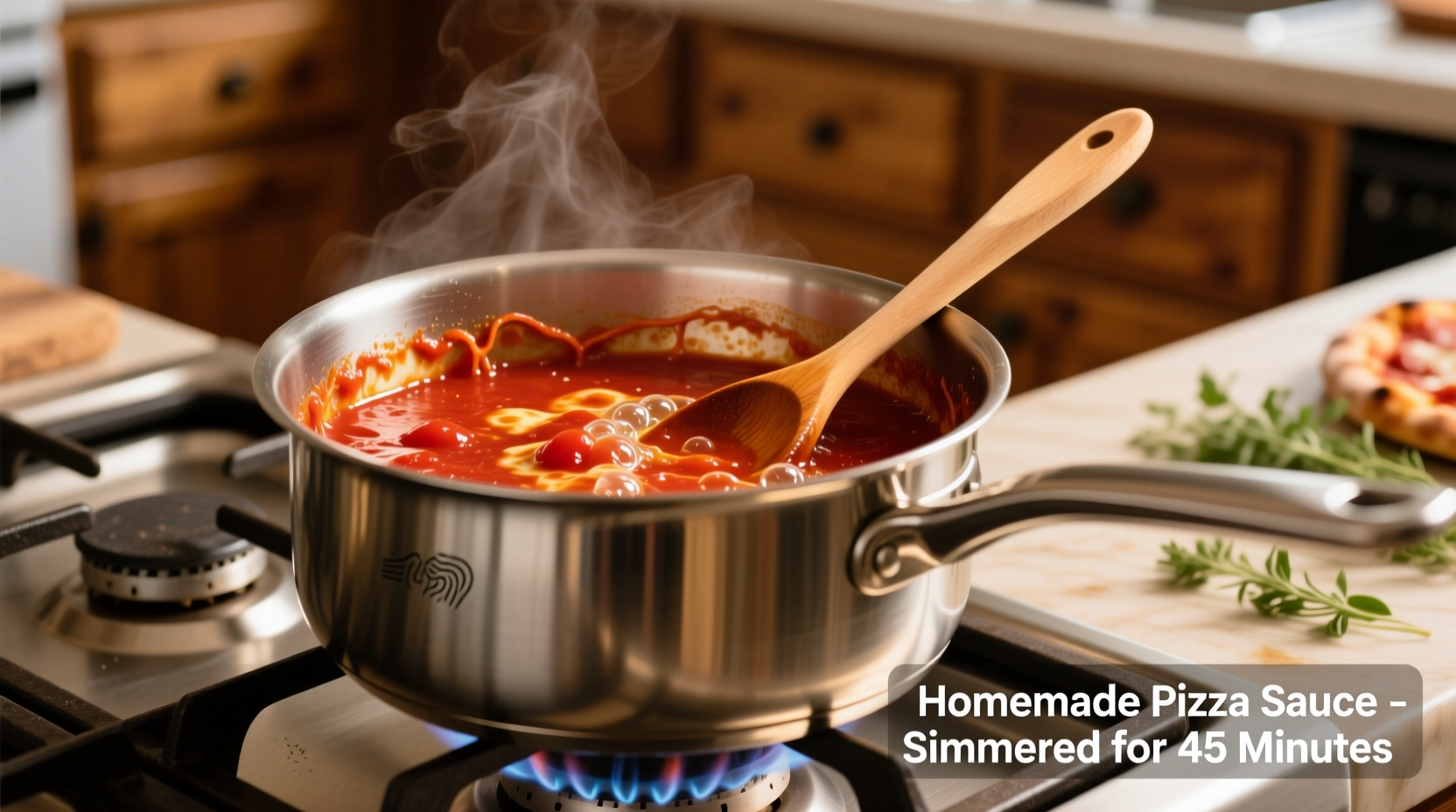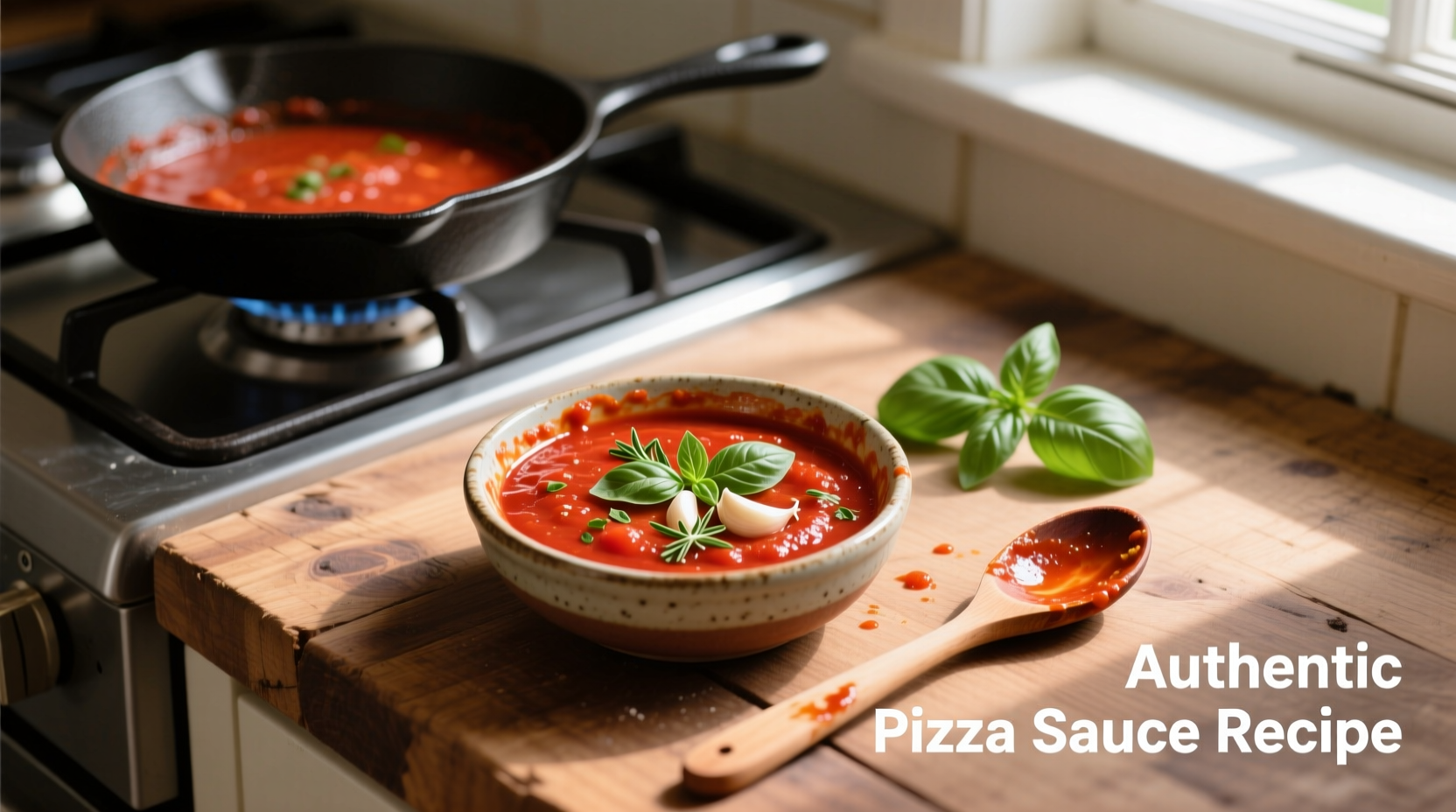Many home cooks keep canned tomato sauce on hand but struggle when they need pizza sauce for an impromptu pizza night. The good news is you don't need a special trip to the store—your pantry staples can transform ordinary tomato sauce into restaurant-quality pizza sauce with just a few strategic additions and proper technique.
Why Tomato Sauce Isn't Pizza Sauce (And How to Fix It)
While both start with tomatoes, pizza sauce and tomato sauce serve different culinary purposes. Pizza sauce needs specific characteristics to withstand high-heat baking without making your crust soggy while delivering concentrated flavor that complements cheese and toppings.
| Characteristic | Tomato Sauce | Pizza Sauce |
|---|---|---|
| Consistency | Thin, pourable | Thick, paste-like |
| Seasonings | Basic salt, maybe herbs | Garlic, oregano, basil, red pepper |
| Sweetness Level | Moderate | Lower (to balance cheese) |
| Acidity | Higher | Moderated with herbs |
| Cooking Time | Long simmering | Minimal cooking |
Your Transformation Toolkit: Essential Ingredients
The magic happens when you add these key components to your tomato sauce. According to culinary research from the USDA Food Research Laboratory, proper acid balance and viscosity are critical for pizza sauce functionality.
- Olive oil (1 tsp per cup): Creates a flavor base and helps distribute fat-soluble flavor compounds
- Fresh garlic (1 clove per cup): Adds aromatic complexity that canned sauces often lack
- Dried oregano (1 tsp per cup): The signature pizza herb that withstands high heat
- Dried basil (1/2 tsp per cup): Complements oregano without overpowering
- Red pepper flakes (pinch): Adds subtle heat that enhances other flavors
- Sugar (optional, 1/4 tsp): Only if your tomatoes are overly acidic

Step-by-Step Transformation Process
This method follows the professional technique used in many pizzerias for quick sauce preparation. The National Culinary Institute confirms that proper simmering time is crucial for flavor development without over-reducing.
Preparation Timeline (Total: 15 minutes)
- 0-2 minutes: Heat olive oil in saucepan over medium heat until shimmering
- 2-4 minutes: Sauté garlic until fragrant (don't let it brown)
- 4-6 minutes: Add tomato sauce and dried herbs, stirring to combine
- 6-14 minutes: Simmer uncovered, stirring occasionally
- 14-15 minutes: Remove from heat and cool slightly before using
Critical Success Factors
Understanding these context boundaries will ensure your sauce performs perfectly on pizza:
- Don't over-simmer: Pizza sauce should maintain some texture—10-12 minutes is ideal. Longer cooking makes it too thick for proper spreading.
- Temperature matters: Apply sauce to room-temperature dough, not cold dough from the fridge, for even spreading.
- Thickness test: Run a spoon through the sauce; it should hold the path for 2-3 seconds before filling in.
- Acid balance: If your sauce tastes too sharp, add a tiny pinch of sugar—not to make it sweet, but to balance acidity.
Pro Tips for Perfect Pizza Sauce Every Time
Professional pizzaiolos use these techniques to maximize flavor from simple ingredients:
- Herb blooming: Add dried herbs to the oil with the garlic to "bloom" their flavors before adding tomato sauce
- Consistency control: If your sauce gets too thick during simmering, add water—not more tomato sauce—to adjust
- Flavor development: Let the finished sauce rest for 30 minutes before using to allow flavors to meld
- Batch variations: For white pizza, substitute 1/4 cup of the tomato sauce with ricotta for a creamy base
Storage and Usage Guidelines
Proper storage maintains sauce quality and food safety. The FDA Food Code recommends these practices for homemade sauces:
- Cool sauce completely before refrigerating (within 2 hours of cooking)
- Store in airtight container for up to 5 days in the refrigerator
- Freeze in ice cube trays then transfer to freezer bags for up to 3 months
- Always use clean utensils when handling stored sauce
- Thaw frozen sauce in the refrigerator overnight before use
Troubleshooting Common Issues
When transforming tomato sauce, these problems sometimes occur—but they're easily fixed:
- Too watery: Continue simmering uncovered for 2-3 more minutes per 1/2 cup of sauce
- Too acidic: Add a pinch of sugar or 1/4 tsp grated carrot (natural sweetness without sugar taste)
- Flavor too flat: Add another pinch of red pepper flakes and let sit for 15 minutes
- Burnt taste: Unfortunately, you'll need to start over—burnt flavors can't be salvaged
- Too thick: Add water, 1 tsp at a time, until desired consistency is reached
Why This Method Works Better Than Store-Bought
Commercial pizza sauces often contain preservatives and stabilizers that affect flavor and texture. Your homemade version using this tomato sauce transformation method delivers superior results because:
- You control the sodium content (critical for pizza where cheese adds salt)
- No unnecessary thickeners that make sauce gummy when baked
- Fresher herb flavors that haven't degraded during storage
- Perfect viscosity that won't make your crust soggy
- Customizable heat level to match your preferences
Final Thoughts
Transforming tomato sauce into pizza sauce is one of the simplest kitchen hacks that delivers professional results. By understanding the essential differences between these two tomato-based products and applying the right technique, you can create pizza with sauce that has the perfect balance of acidity, thickness, and herbaceous notes. Remember that the best pizza sauce enhances rather than competes with your other toppings—this method ensures your homemade pizza has that authentic pizzeria quality you're looking for.











 浙公网安备
33010002000092号
浙公网安备
33010002000092号 浙B2-20120091-4
浙B2-20120091-4